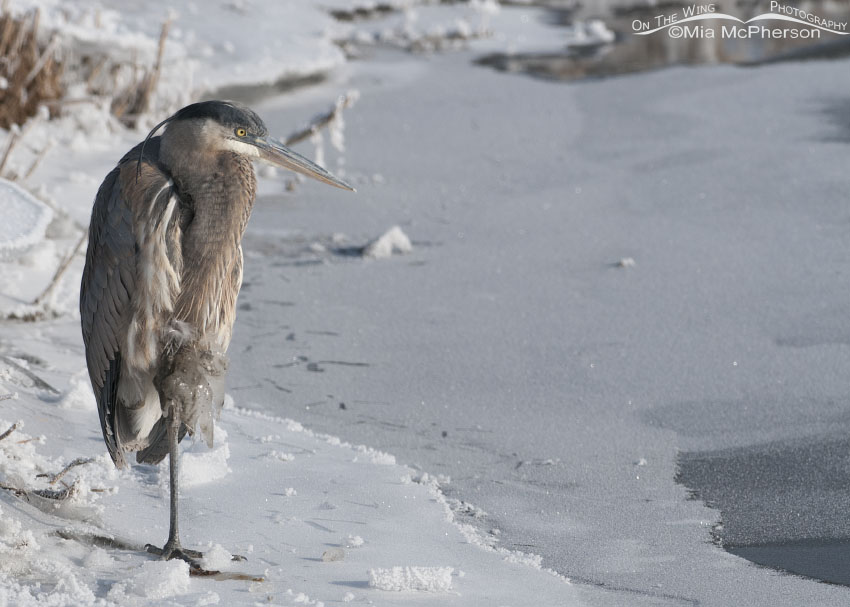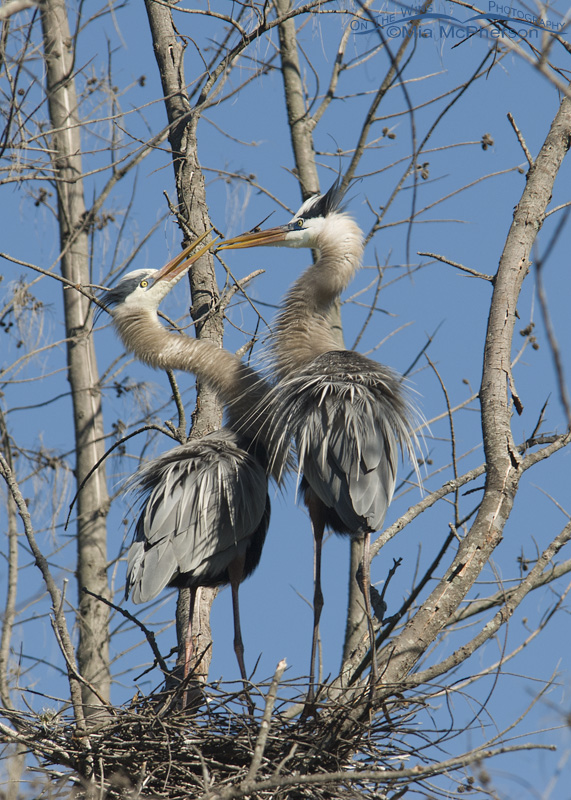There is a big difference in what Great Blue Herons do in December in Utah and Florida and since I have lived and photographed these large wading birds in both places I thought I would share a few of the differences.
 One very cold Great Blue Heron – Nikon D300, f7.1, 1/2000, ISO 500, +0.7 EV, Nikkor 200-400mm VR at 280mm, natural light
One very cold Great Blue Heron – Nikon D300, f7.1, 1/2000, ISO 500, +0.7 EV, Nikkor 200-400mm VR at 280mm, natural light
In Utah most of the Great Blue Herons are year round residents who during the winter live in extremely cold temperatures, icy fog, blowing snow and days to weeks where the water in the marshes is completely frozen over. Fishing for food gets harder and harder when there is very little open water so they start to hunt for voles in the deep snow. They spend time in frigid water searching for prey and move slowly to conserve their precious energy reserves.
I photographed the Great Blue Heron in the photo above one bitter cold morning in December of 2013 at Farmington Bay WMA in northern Utah while it stood on a shelf of snow covered ice near where there was some open water for it to hunt in. It might be hard to see at this resolution but there is a huge chunk of ice frozen onto its feathers just above the top of the one leg the bird was standing on. I’d bet that hunk of ice weighed a pound or two and that it formed overnight while the Great Blue Heron slept in the cold water.
Just one photo can show a lot of what they live through. Utah’s Great Blue Heron don’t have it easy during December or the rest of winter, these wading birds have to be tough.
 Great Blue Herons squabbling at their nest – Nikon D200, handheld, f6.3, 1/800, ISO 200, Nikkor 80-400mm VR at 330mm, natural light
Great Blue Herons squabbling at their nest – Nikon D200, handheld, f6.3, 1/800, ISO 200, Nikkor 80-400mm VR at 330mm, natural light
Florida’s Great Blue Herons don’t have it so bad during December. They usually start courting, building nests and laying eggs during December. They squabble and work together to build their nests in their finest breeding plumage. They don’t usually have to deal with temps that drop below freezing and even when that does occur it is usually just for a couple of hours. They hunt for food in open water and stalk small rodents and reptiles in fields that aren’t covered in deep snow.
I photographed this squabbling pair of nesting Great Blue Herons in December of 2008 at Fort De Soto County Park. The male had brought in a stick for the nest and the female seemed to be disagreeing about the placement of the stick, she moved it after this photo was taken.
The lives of these Great Blue Herons sure are different when you compare December in Utah to December in Florida.
Life is good.
Mia
Click here to see more of my Great Blue Heron photos plus facts and information about this species.


Birds are incredibly adaptable aren’t they?
Stunning images – as always.
Great pics MIa. Simply great! Your photos always light me up. Thanks.
Wonderful, wonderful images! Can identify with bird in first image. This house is always cold in winter and I huddle up like that in my nylon vest…the composition in that first one is especially nice…love the action in the second ( and wish I was that warm)…
Wonderful, wonderful images! Can identify with bird in first image. This house is always cold in winter and I huddle up like that in my nylon vest…the composition in that first one is especially nice…love the action in the second ( and wish I was that warm).. C
Thank you Mia for sharing your photos and blog. I am glad I found you in one of my bird groups on Facebook.
Watching one right now in our south Florida back yard lake. A cold front is fast approaching and we will drop from the high 79s to the mid 40s by tonight. No comparison to the challenges of a Great Blue Heron in Utah at this time of year!